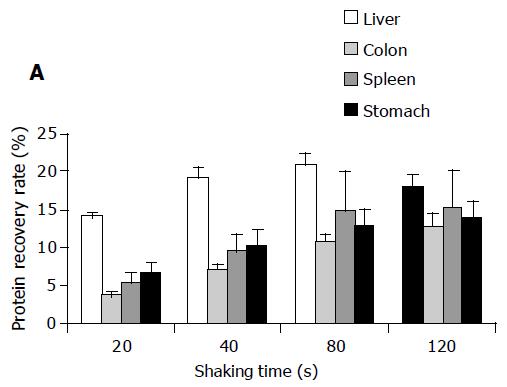Copyright
©The Author(s) 2005.
World J Gastroenterol. Sep 7, 2005; 11(33): 5162-5168
Published online Sep 7, 2005. doi: 10.3748/wjg.v11.i33.5162
Published online Sep 7, 2005. doi: 10.3748/wjg.v11.i33.5162
Figure 2 Determination of the optimal shaking time for tissue lysis by the MagNA Lyser.
Tissue pieces in sizes ranging from 150 to 200 mg were subjected to reciprocal oscillation by the MagNA Lyser at 6 500 r/min for different time periods. Protein concentrations of tissue lysates were assayed, and protein recovery rates were calculated as above. Additionally, an aliquot (200 mg) of each tissue lysate was resolved on a 7-cm IPG strip, pH 3-10, then run in an 8×9-cm 12% SDS-polyacrylamide gel, and visualized by AlphaImager 2000 after staining with Coomassie blue dye. The optimal shaking time for tissue lysis by MagNA Lyser was determined according to both the protein recovery rates (A) and the protein profiling from 2D gel electrophoresis (B).
- Citation: Chen WS, Chang HY, Chang JT, Liu JM, Li CP, Chen LL, Chang HL, Chen CC, Huang TS. Novel rapid tissue lysis method to evaluate cancer proteins: Correlation between elevated Bcl-XL expression and colorectal cancer cell proliferation. World J Gastroenterol 2005; 11(33): 5162-5168
- URL: https://www.wjgnet.com/1007-9327/full/v11/i33/5162.htm
- DOI: https://dx.doi.org/10.3748/wjg.v11.i33.5162









